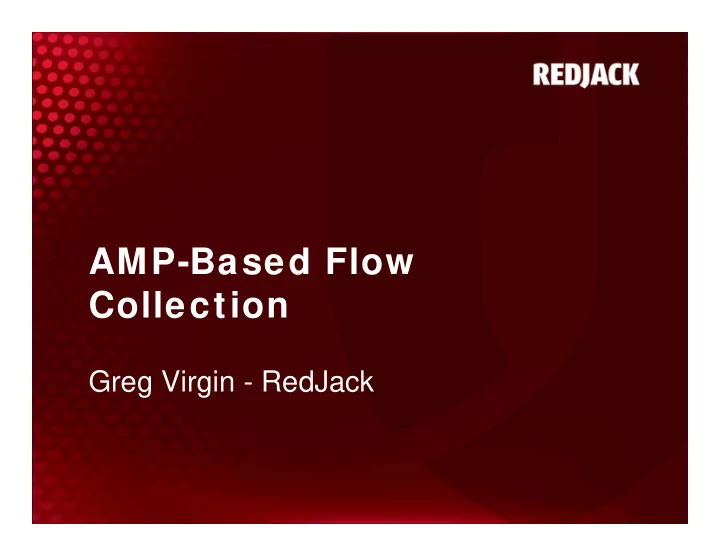

AMP-Based Flow Collection Greg Virgin - RedJack
AMP- Based Flow Collection • AMP - “Analytic Metadata Producer”: Patented US Government flow / metadata producer • AMP generates data including • Flows • Host metadata (TCP stack information, software banners) • Metrics • Purpose of this talk: To discuss the flow data collection implications of these additional data types for forensic analysis (not just correlation and alerting) • Additional data sources • Analysis scenarios • Collection schemes
Additional Data Sources • Core data source: flow data • Netflow-like data with additional TCP flag information • Flow-derived data sources: port details • Ports accepting connections • Bandwidth statistics • Additional data sources (Not appropriate for flow records- aggregated data sources by IP, not communication) • TCP Stack information reflecting running O/S • Server Banners (as seen by the Internet) • Client Banners (as sent to the Internet) • DNS Names collected from both the DNS protocol and other protocols (NEVER trust DNS!) • Search strings from search engines (HTTP “referer” tags)
Scenario 1: Server “Importance” • Server Profile • Configuration (“Windows 2000”) • List of listening ports (80, 443) • List of available services (“IIS/6”) • Domain name(s) (“www.golfcarts.com”) • Traffic Volume (X connections today, per week, per month) • Associated search strings (“golf carts”, “high performance golf carts”) • Why? • Provides metrics to automatically partition servers by volume, type, vulnerability • Provides forensic value through server details often unavailable at time of analysis • Flow analysis scenarios: • Which active servers were impacted by flow traffic / scans / attacks • Scrutinize payload-bearing traffic going to these servers • Make sure you’re not picking up potentially “normal” activity in other anomaly detection approaches (your concept of normal doesn’t necessarily have to be perfect) • Assign real world concepts to traffic activity and perform sanity checks through search strings
Scenario 2: DNS / Name Analysis • Naming Information: • DNS Response packets • HTTP Get requests, mail protocol name announcements • Why? • The current DNS implementation presents major risks because threats can masquerade as well known sites • The web protocol is dominated by virtual servers • We have found interesting discrepancies between DNS and naming in other protocols • Dealing with hosts as domain names is more natural (the purpose of the protocol) • Flow analysis scenarios: • Name-based queries (possible with SiLK) • Names or name checksums incorporated into flow records for web traffic, followed by correlation with a name for the IP once the data is collected (helps with virtual servers) • Forensic analysis of traffic to or from bogus domain names to determine potential damage (but you have to do the above correlation first)
Scenario 3: Making IP Space Heterogeneous • Required data: • Host Configuration • listening ports • running services • Why? • Too often IP space is considered one big homogeneous blob - analysis is done on traffic between nodes without considering types of nodes • The diagnosis of activities such as worms can be made from hosts in a set running the same piece of software rather than signature • Flow analysis scenarios: • What has been called a “similarity” analysis: take an IP set and run it against host profiles to provide statistics on what the hosts in the set have in common • Flow analysis broken down by host attributes isn’t very common, so there are a number of possibilities
Scenario 4: The “Alternate Use” Flag • Marking flows for statistically significant attributes is marking flows based on signatures, not necessarily “new” data • “Alternate Use” refers to the proper use of an Internet protocol without being used for the purpose of the protocol (this is not protocol analysis) • Why? • This type of traffic can be a huge portion of the traffic • Of unique DNS names seen by your network, more than half of them may come from just a handful of sources • Flow analysis scenarios: • Often port and protocol numbers are considered synonymous with legitimate use of protocols; this can be used to filter out alternate uses • Most of the “alternate” uses for DNS appear to be spam reporting, that information could be harvested
Scenario 5: IDS Verification • Use host information or flow data to validate IDS records • If hosts aren’t running the software that IDS signatures think they are… • Not a new concept and done in practice
Summary of Scenarios • New data sources can be used with flow data to: • Add contextual information and increase situational awareness • Create filters that could be useful for both queries and data collection • Partition data into bins or streams with more (or less) analytic meaning • The best result is for these techniques to impact the data or be recorded as additional data • This has an obvious impact on collection infrastructure • Data production software should be able to mark, reformat, or drop flow data based on this information • Data collection and storage software should be able to process or partition this information • Since most of these techniques don’t amount to much more than a filter definition, a registry for these filters that different parts of the flow collection infrastructure can use is appropriate
New Sensor Attributes • (This is in addition to flows with TCP options, host information, and DNS) • Filters based on additional information • Domain name value for the web protocol • “Alternate Use” flag • Not yet discussed: • Change ICMP to include third IP address in some instances
New Data Collection Attributes • Marking or partitioning flows with domain names • Metrics, filtering, and additional aggregation (flows for large servers can be compacted)
New Data Store Attributes • Flow data closely tied to new data sources • Registry for filtering techniques that can be leveraged by the sensor and collection • Questions? • Greg Virgin, greg.virgin@redjack.com
Recommend
More recommend